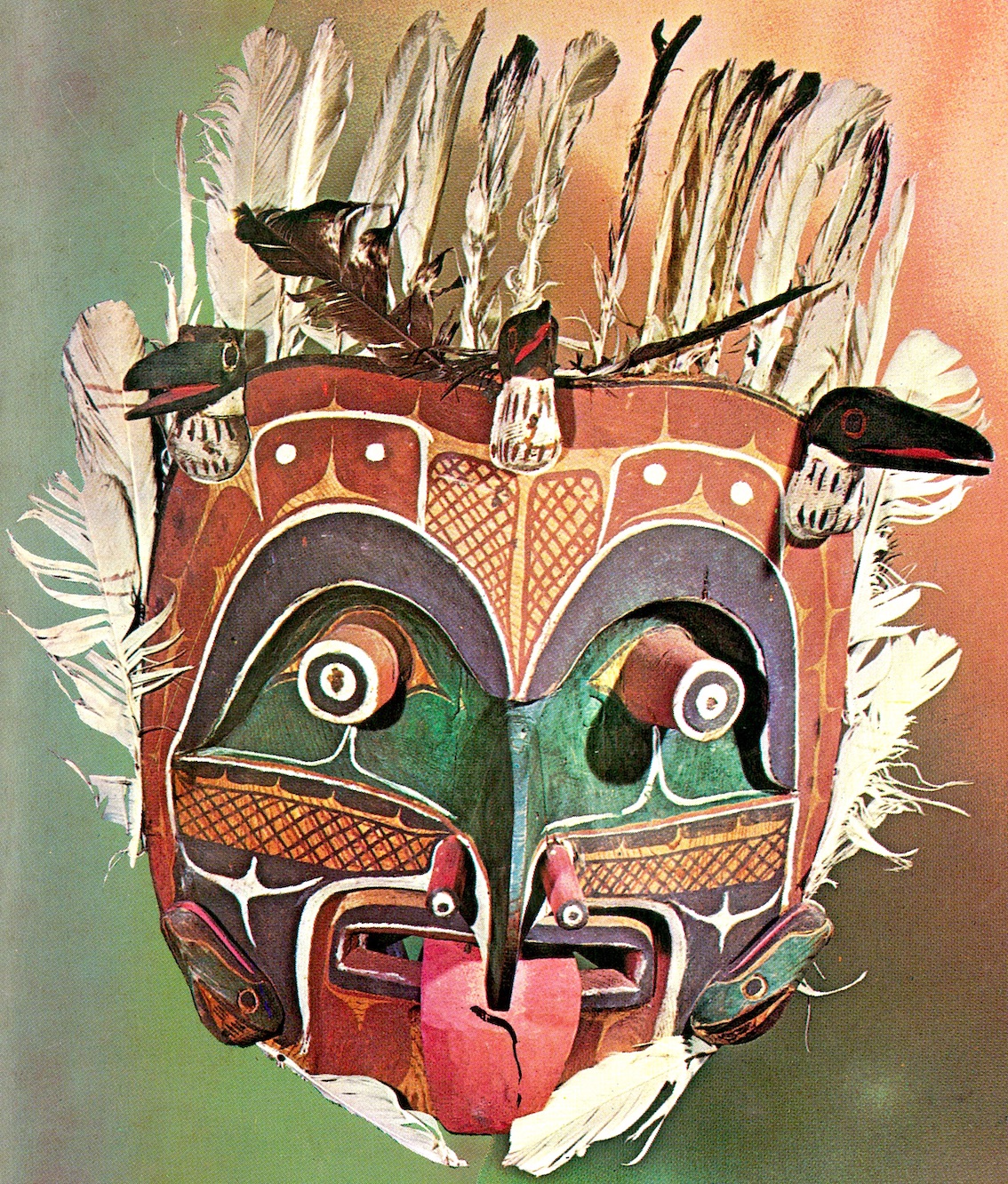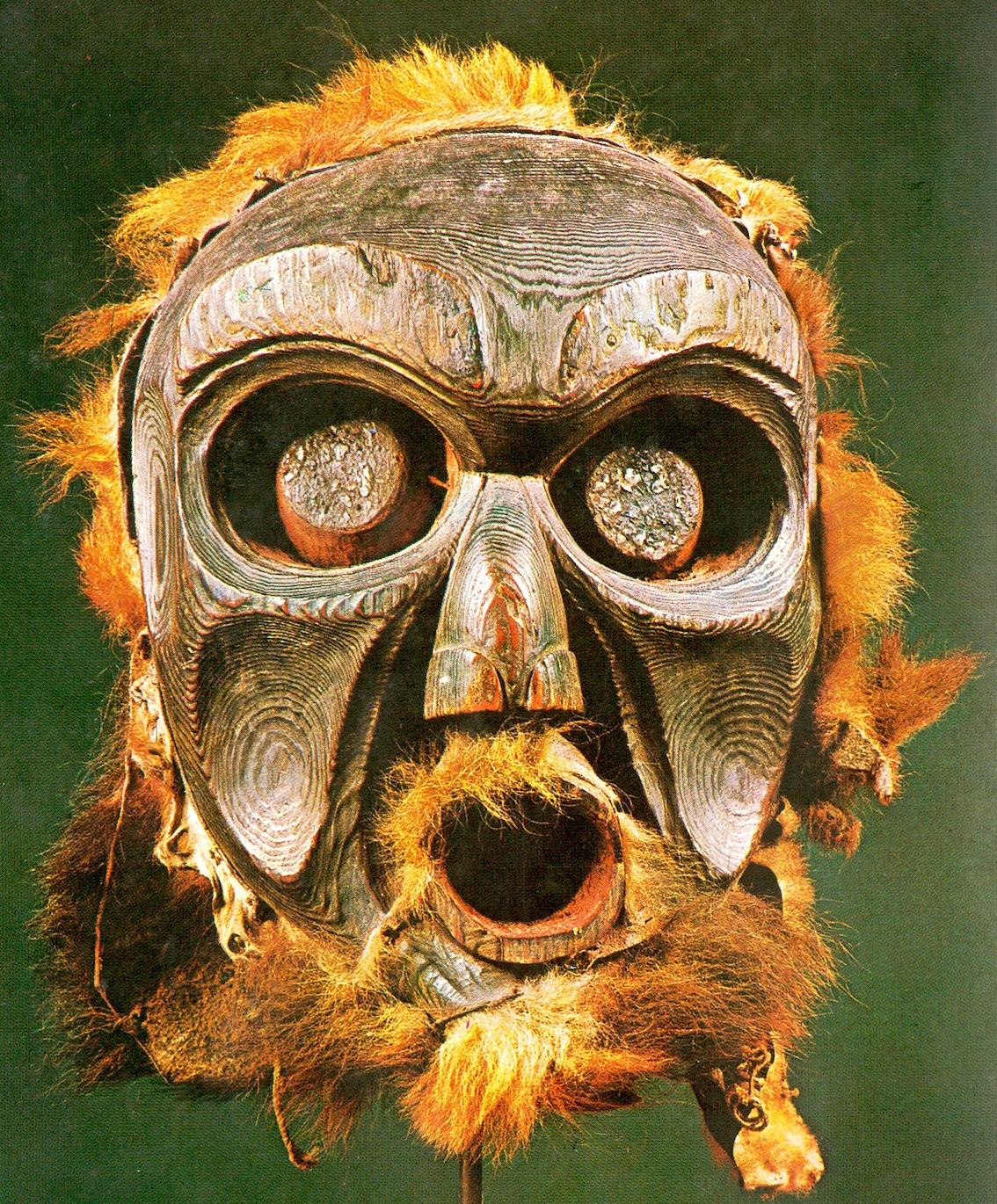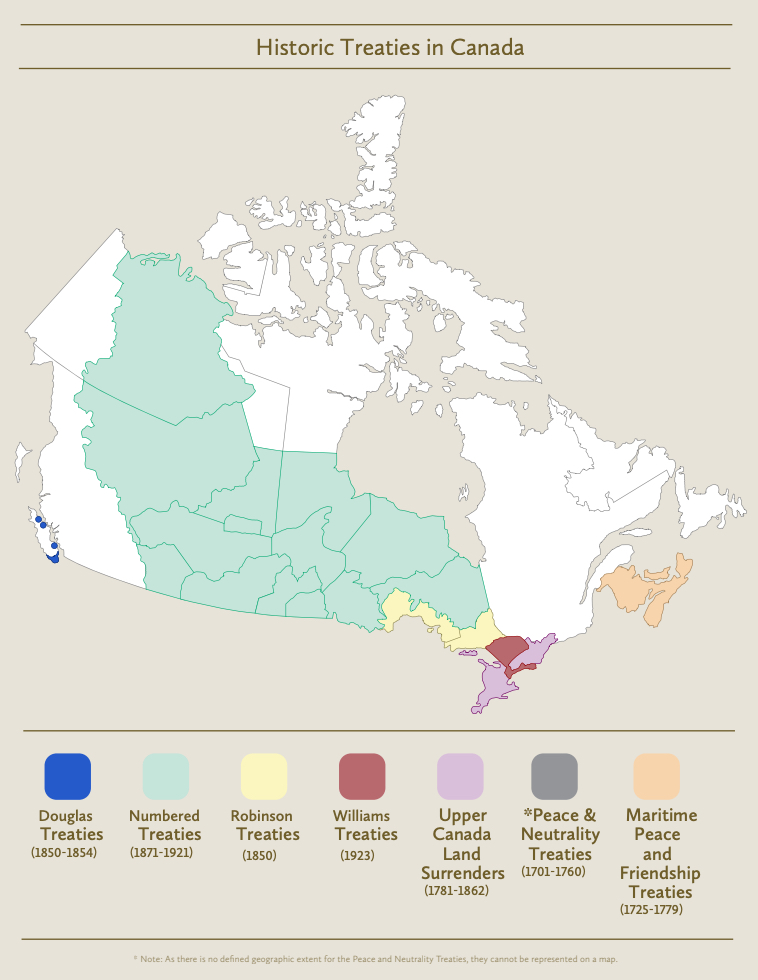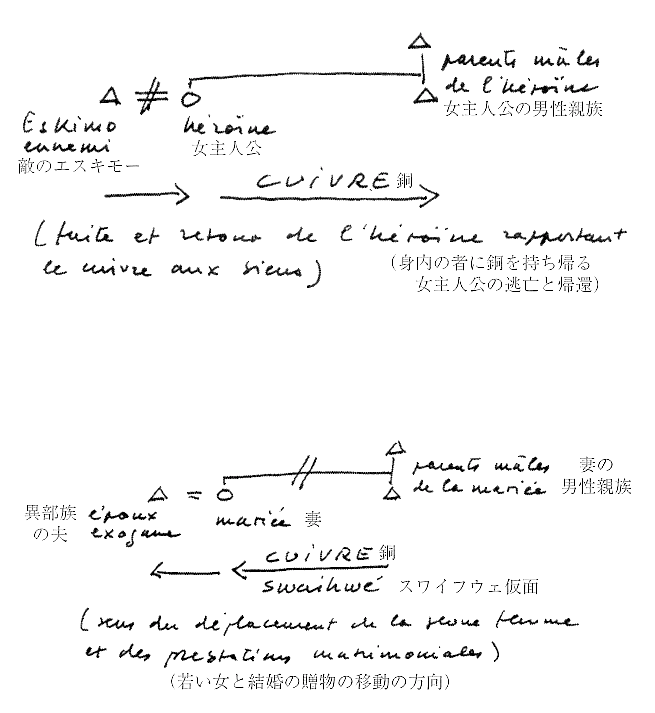

レヴィ=ストロース『仮面の道』研究ノート
La voie des masques
 |
 |
| 地震の神(→鯰絵, 243)、クウェクウェ仮面(→スワイフウェ,
p.72,
79)、クワクワカワク、ニューヨークアメリカ自
然史博物館蔵 |
〈ゾノクワ〉の仮面(43X34CM)。クワクワカワク。1870-
1880年頃作成。ヤコブセンコレクション、ベルリン人類学博物館 |
第1部 仮 面の道
第一巻
第二巻
第2部 三 つの小さな旅
2-1 スワイフウェを超えて
2-2 クワキウトル族の社会組織
2-3 仮面の裏側
注など
冒 頭の長い彼のノートの記述……
左 より:民族分布、民族分布(L=Sの著作より)、スワイフウェ仮面の呼称の多様性
| トリンギット |
Tlingit |
The Tlingit (/ˈklɪŋkɪt/ or
/ˈtlɪŋɡɪt/; also spelled Tlinkit; ) are indigenous peoples of the
Pacific Northwest Coast of North America.[2] Their language is the
Tlingit language (natively Lingít, pronounced [ɬɪ̀nkɪ́tʰ]),[3] in which
the name means "People of the Tides".[4] The Russian name Koloshi (from
a Sugpiaq-Alutiiq term kulut'ruaq for the labret worn by women) or the
related German name Koulischen may be encountered referring to the
people in older historical literature, such as Shelikhov's 1796 map of
Russian America.[5] The Tlingit have a matrilineal kinship system, with
children considered born into the mother's clan, and property and
hereditary roles passing through the mother's line.[6] Their culture
and society developed in the temperate rainforest of the southeast
Alaska coast and the Alexander Archipelago. The Tlingit maintained a
complex hunter-gatherer culture based on semi-sedentary management of
fisheries.[7] An inland group, known as the Inland Tlingit, inhabits
the far northwestern part of the province of British Columbia and the
southern Yukon Territory in Canada. +++ トリンギット族(/ˈɪ or /ˈɪŋŋɡɪ; Tlinkitとも表記される。言語はトリンギット語(ネイティブではLingít、発音は[ɬɪ́↪Ltɪ])で、名前は「潮の民」を意味する。ロシア 語のKoloshi(Sugpiaq-Alutiiq語のkulut'ruaqで女性がかぶる口ひげに由来する)またはドイツ語のKoulischen は、シェリホフの1796年のロシア領アメリカ地図など、古い歴史的文献に登場する。 トリンギット族は母系血縁制をとっており、子供は母親の一族に生ま れたとみなされ、財産や世襲的な役割は母親の血筋を受け継ぐ。彼らの文化と社会は、アラスカ南東部沿岸の温帯雨林とアレキサンダー群島で発展した。トリン ギット族は半定住型の漁業管理に基づく複雑な狩猟採集文化を維持していた。インランド・トリンギットとして知られる内陸部のグループは、カナダのブリ ティッシュ・コロンビア州の北西部とユーコン準州南部に居住している。 |
| ハイダ |
Haida people |
Haida
(English: /ˈhaɪdə/, Haida: X̱aayda, X̱aadas, X̱aad, X̱aat) are a nation
and ethnic group native to, or otherwise associated with, Haida Gwaii
(an archipelago located off the west coast of Canada and immediately
south of Alaska) meaning "Coming out of concealment" or sometimes
"island of the People", and the Haida language.
The Haida are known for their craftsmanship, trading skills, and
seamanship. They are thought to have been warlike and to practise
slavery. Anthropologist Diamond Jenness has compared the Haida to
Vikings while Haida have replied saying that Vikings are like Haida.[2]
In Haida Gwaii, the Haida government consists of a matrix of national
and regional hereditary, legislative, and executive bodies including
the Hereditary Chiefs Council, the Council of the Haida Nation (CHN),
Old Massett Village Council, Skidegate Band Council, and the
Secretariat of the Haida Nation. These are based in the archipelago of
Haida Gwaii (formerly the Queen Charlotte Islands) outside the
territorial seas of Canada off of northern British Columbia, Canada.
The Kaigani Haida live north of the Canadian and US border which cuts
through the Dixon Entrance on Prince of Wales Island (Tlingit: Taan) in
Southeast Alaska, United States; Haida from Kiis Gwaii in the Duu Guusd
region of the Haida Gwaii migrated north in the early 1700s. Following
the accidental death of a Haida by a Tlingiit the Haida were formally
given territories by the Tlingiit governments. Haida have occupied
Haida Gwaii since at least 14,000 BP, and evidence has shown that there
has been constant habitation on the islands for at least 6000 years.
Pollen fossils and oral histories both confirm that Haida ancestors
were present when the first tree, a Lodgepole pine, arrived at SG̱uuluu
Jaads Saahlawaay, the westernmost of the Swan Islands located in Gwaii
Haanas.[3] +++ ハイダ(英語: /ˈ haˈ, Haida: X̱aadas, X̱aad, X̱aat)は、ハイダ・グワイ(カナダの西海岸沖、アラスカのすぐ南に位置する群島)の先住民、またはそれに関連する民族であり、「隠蔽から出る」、ま たは「民の島」を意味するハイダ語を話す。ハイダ族は、職人技、交易技術、航海術で知られている。彼らは戦争好きで、奴隷制を実践していたと考えられてい る。人類学者のダイアモンド・ジェネスはハイダ族をバイキングに例えているが、ハイダ族はバイキングはハイダ族に似ていると答えている[2]。ハイダ・グ ワイでは、ハイダ族政府は継承酋長評議会、ハイダ民族評議会(CHN)、オールド・マセット・ビレッジ評議会、スキデゲート・バンド評議会、ハイダ民族事 務局など、国と地域の世襲・立法・行政機関のマトリックスで構成されている。これらはカナダのブリティッシュ・コロンビア州北部沖のカナダ領海外にあるハ イダ・グワイ諸島(旧クイーン・シャーロット諸島)を拠点としている。カイガニ・ハイダは、アメリカ南東部アラスカのプリンス・オブ・ウェールズ島(トリ ンギット語ではタアン)のディクソン・エントランスを通るカナダとアメリカの国境の北側に住んでいる。ハイダ・グワイのドゥウ・グウスド地域のキイス・グ ワイ出身のハイダは、1700年代初頭に北に移住した。トリンギット人によるハイダ人の事故死をきっかけに、ハイダ人はトリンギット政府から正式に領土を 与えられた。ハイダ族は少なくとも紀元前14,000年前からハイダ・グワイイを占拠しており、少なくとも6,000年前からこの島には常に人が住んでい たことが証明されている。花粉化石と口承伝承の両方が、グワイ・ハナスに位置するスワン諸島の最西端、SG̱uuluu Jaads Saahlawaayに最初の木、ロッジポールパインが到達したとき、ハイダの祖先が存在していたことを裏付けている[3]。 |
| ツィムシアン |
Tsimshian |
|
| ベラ・クーラ |
Bella Coola |
|
| クワクワカワク |
Kwakwaka’wakw |
「ク
ワキウトル族は北アメリカ大陸北西海岸地域(カナダ・ブリティッシュコロンビア州バンクーバー島東岸北部から、その対岸の大陸側沿岸地域)に居住し、ワカ
シュ語族[要出典]に属するクヮキゥートル語を話すインディアンである。
なお、書物で一般的な呼び名の「クワキウトル」は古くからの英語表記Kwakiutlをベースにカナ表記されたものであるが、現在カナダでは先住民の権利
保護の進展に伴い、民族が自称するKwakwaka'wakwと呼ぶ傾向にある。日本語書物では「クワクワカワク」あるいは「クヮクヮカワク」と表記され
るが、民族自称の発音は、「クヮクヮキワク」ないしは「クワクワキワク」[kwakwakiwak](アクセントは最終音節)である。
クワキウトル族は、コーモラント島とバンクーバー島本島北東部の一部を生活圏としたナムギス族 (Namgis)
など多くの支族に分かれ、ナムギス族のコーモラント島アラートベイ (Alert Bay)
がその中心集落であった。文化人類学、言語学上の分類では、キティマート (Kitimat) 周辺のハイスラ族、ベラベラ (Bella
Bella) のヘルツーク族 (Heiltsuk)
を北クヮクヮキワク族と分類する例もあるが、当のヘルツーク族、ハイスラ族の人々に、自分たちがクワキウトル族の一部との認識はない」https://x.gd/k4y7Z |
| ヌートカ |
Nootka |
|
| サリッシュ |
Salish |
|

From,
City of Vancouver,"First Peoples: A Guide for Newcomers,"
2014

リンク
文献
Copyleft, CC, Mitzub'ixi Quq Chi'j, 1996-2099
++
Copyleft,
CC, Mitzub'ixi Quq Chi'j, 1996-2099